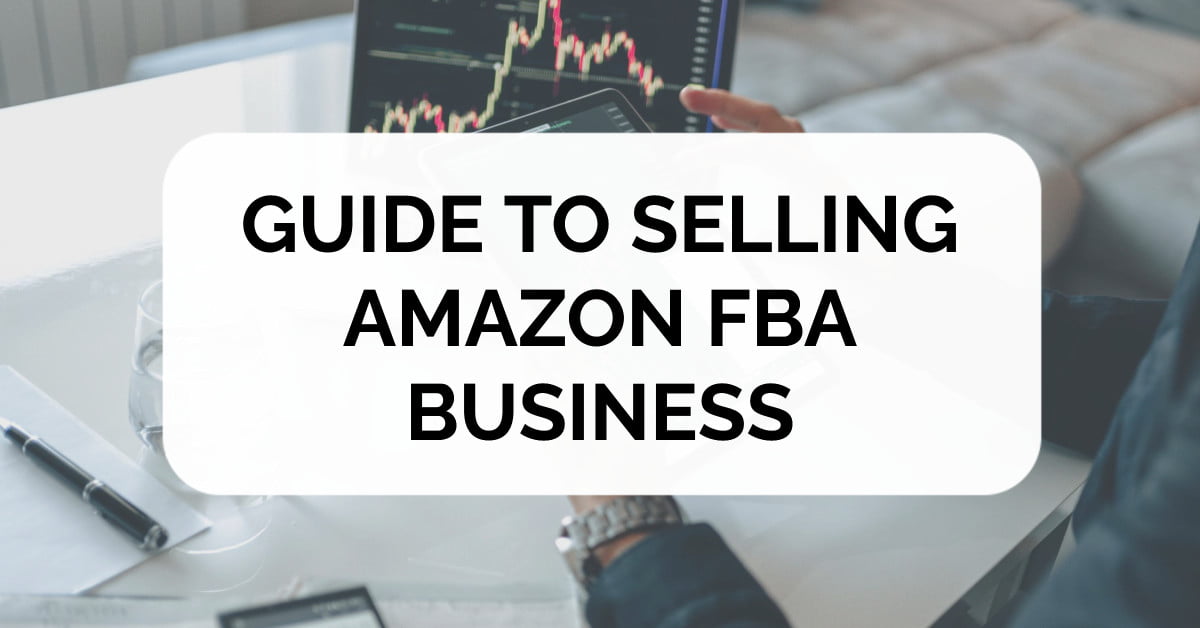If you were to sell your Amazon FBA business, where would you start?
If you’re not sure, you’re in the right place.
We’re going to walk through every stage of selling your Amazon FBA business, from initial preparation to negotiating the deal and everything in between.
The only thing we won’t cover is the migration of your business to the new owner, because that would warrant its own ultimate guide. That said, if you’d like to learn about migrations, then we’ve written a helpful article about how it’s done for Amazon FBA businesses.
As for everything else, let’s start with preparation.
This is a guest blog post written by Empire Flippers. Empire Flippers is an Inc. 500 company and the #1 curated marketplace for buying/selling established and profitable online businesses.
Preparing Your Amazon FBA Business for Sale
Even if you don’t end up selling your business, understanding how to prepare your business for sale helps you build a better and more profitable business. Knowing your business inside out is the best place to start.
Do you know your monthly ingoings and outgoings? Do you know how many customers you have? Do you know how much traffic you get to your website? Do you know what your customer acquisition cost (CAC) is for your marketing?
These are examples of the core questions you need to know the answers for.
Imagine a new buyer who has never seen your business before and what questions they would ask you. Better yet, think about the questions you would ask a business owner to understand their business.
The four main areas of your business you need to know cold are:
- Finances
- Operations
- Inventory
- Traffic
We’re about to dig into each of these areas since knowing them is crucial not only when preparing your business for sale, but also for keeping your business alive.
For example, if you’re making 80% of your sales from one of your five SKUs, when that product stops selling you lose 80% of your revenue and your business could die as a result.
On the surface, it might seem like things are going swimmingly with your Amazon FBA business – profits are steady, traffic levels are consistent, and it’s not taking too much of your time to run. It doesn’t mean there isn’t a disaster waiting around the corner, however.
All it can take is a supplier issue or your seller account receiving a temporary ban from Amazon to cause your business to sink.
This is why knowing your business inside out will help you maintain your business and make it as self-sustaining as possible, which is exactly what a business buyer wants.
Let’s start with the most important area of your Amazon FBA business – its finances.
Know Your Numbers
While it’s easy to look at your revenue figures with a smile, you should also be asking yourself how much money you’re banking, as well as how much you’re spending.
Knowing your ingoings and outgoings alone enables you to understand the profitability of your business. A business can be making $400,000 a month in revenue, but if it’s spending $350,000 a month, then it only brings in $50,000 profit. Ask yourself if you are making the maximum amount of profit possible from the revenue your business is generating.
Take a common problem often overlooked by Amazon sellers: when calculating their monthly sales, they don’t account for the number of products that will be returned by customers.
When a customer returns a product, you are not reimbursed the FBA fee you paid for that product’s sale and you have to pay a refund fee as well. Even if you can resell the product, you’ve already made a substantial loss.
Returns could be eating away at your profits without you even knowing it. This is just one reason why it is so important to drill down on your figures and see how healthy your business is.
The best way to get a clear picture of your business’ finances is to create a detailed profit and loss (P&L) statement.
You can use a simple spreadsheet for this, although it can make more sense to use cloud-based software. If you want to optimize your finances and pay the minimum amount of tax, then working with an accountant could be the answer.
Organize Your Operations
Similar to finances, you want to make sure your operations are as efficient as possible, too.
How much time you spend working on your business is one of the most important valuation factors a buyer interested in your business will consider. Few buyers want to acquire a business that takes more than 10 hours a week to maintain.
As for scalability, the hours you’re working on maintaining it is time you don’t have to focus on growing it.
Using a software tool like Jungle Scout to automate your inventory ordering can instantly shave hours off the time you spend running your business. There are other tools for pretty much everything to do with running an FBA business, so take a look at your operating procedures and see where you can use software to automate processes.
Before you do that, however, you need to get clear on your processes. The best way to do this is to write them down. Creating documents called “standard operating procedures” (SOPs) is the best way to make your operations more efficient.
An SOP is a set of instructions that outlines how to carry out a particular operation or task. For example, if you do Amazon PPC, you might have procedures for carrying out keyword research that you repeatedly do. Write this procedure down into a document.
Having repeatable processes is key to making business operations efficient and it greatly improves your business. Especially for a new buyer who wants to easily see how your business functions for when they take it over.
Get On Top of Your Inventory
While for Amazon FBA it is Amazon who handles order fulfilment, you still need to have reliable suppliers, order the right amount of inventory, and pay the best price for your stock.
Demand forecasting is a key component of inventory management. If you order too little inventory, you risk stock-outs, which means lost sales and reduced trust in your brand. If you order too much inventory, you’ll be subjected to high storage fees and if you have perishable items, you can also lose stock.
Poor inventory management can cost your business a lot of money when you consider the incurred fees and lost sales – just look at the lifetime value of one of your customers to see how much losing sales costs you.
On the flip side, good inventory management prevents losing money in these areas while saving you inventory carrying costs, as the warehouse saves on labor associated with handling your goods.
Using a software tool like Jungle Scout for your inventory ordering will improve your inventory management while at the same time making your operations more efficient, saving you time and money.
Clear Up Your Traffic
Traffic is the lifeblood of any online business. Without traffic, the business doesn’t make sales.
Whether you generate your traffic from Amazon organically, from Amazon PPC, or any other PPC (like social), you should know how much traffic you’re generating, the main channels it’s coming from, and what percentage of your traffic is converting into customers.
Knowing your conversion rates can tell you how effective your ad and keyword targeting is and help you keep on top of your marketing finances. If you’re spending too much to acquire customers, you might want to double-check if your ads are even profitable.
Having a track record of your traffic figures is also a great help for a buyer when assessing your business for sale. Even if you aren’t generating significant traffic to your Amazon store, or if you have run paid campaigns that were somewhat unsuccessful, those are opportunities for a buyer to grow your business.
Those are the fundamental factors to work on when preparing your Amazon FBA business for sale. Now let’s take a look at how your business is valued.
How Your Amazon FBA Business is Valued
As you can imagine, there are quite a few factors involved in valuing an Amazon business. Before we dive into them, it’s important to mention that no matter how much work or capital you’ve invested into your business, it won’t be considered when valuing your business. Also, no matter how much potential you believe your business has, that won’t be considered either.
These are the harsh truths that trip sellers up during negotiations, which we’ll cover in just a moment.
The first and most important metric that buyers and brokers will look at when valuing an online business is profitability. In most cases, the more money a business makes, the more it’s worth.
The other valuation factors that are considered are:
- Baseline factors:
– The type of business you run
– What the age of your business is
– How many hours per week you spend on your business - Financial health:
– How consistent your profits are over a time period (usually 12 months)
– How much traffic you get to your store - Life sources:
– The number, consistency, and location of income generators
– The number, consistency, and location of traffic generators - Brand strength:
– Review quality and volume
– How easy your product is to copy
– How niche your brand is
– The ranking you have on Amazon’s hot keywords
– The social media presence your brand possesses
– How established your brand is in the niche - Owned assets:
– The business product line
– Trademarks associated with your business
– Contracts for employees
– Contracts for suppliers
– Email lists
– Business accounts for social media
By assessing these factors, we can determine your business multiple – the figure generated and added to the valuation formula for calculating your business value.
A basic way to get a baseline valuation figure for your business is to take your average monthly net profit (usually taken over a 12-month period) and times that by a sales multiple.
The average sales multiple for an Amazon FBA business on our marketplace in 2019 was 26x. We’ve increased our baseline multiple for Amazon FBA businesses since then to 31x.
There are three sides to online business valuations: your side (the price you want and the time you want to sell), the third party/broker’s side (looking at the factors listed above), and the buyer’s side (including their competencies and goals).
Let’s take a close look at what you can expect buyers to want when they size up your business for purchase.
What Buyers Look for in an Amazon FBA Business
There are different types of online business buyers, and each has their own set of criteria and personal investment goals. We’ve found there are six main types of buyers:
- Newbies
- DIYers
- Flippers
- Strategists
- Portfolio buyers
- Investors
This diversity of buyers is good news for you, because it means that no matter what stage your Amazon FBA business is at, there could be a buyer out there for you.
Some, like DIYers, want businesses that need improvements, such as inventory management or operational organization. Others, like investors, want businesses that are almost completely hands-off with established brands and high earnings. However, there are some general qualities that most buyers look for.
For your Amazon FBA business, any buyer’s focus will be on your product: its quality, the demand for it, how it ranks in Amazon for popular keywords, and its reviews. While these are the ‘must haves’, standards will differ between buyers.
We conducted an ROI study on Amazon FBA business acquisitions and found out what the buyers went looking for when acquiring businesses. The most popular attributes were steady growth in traffic and revenue, room to grow the business, product and niche, prices and profits, and product quality. As for what buyers wanted to avoid, they didn’t want businesses with large shifts in traffic and revenue, with no room for growth, requiring excessive time and effort to maintain, and with products that could be copied easily by competitors.
What we can take away from these insights is that if your business has steady earnings, opportunities for growth in place (such as new market expansion potential or additional monetization options), quality products that aren’t easily replicated, minimal maintenance effort, and reasonable prices with low margins, then you are in a good position to sell.
That said, even if your business isn’t doing so well in certain areas, you should still be able to find a buyer. Maybe you experienced a stock-out one month and that affected your earnings history, or perhaps your seller account was banned temporarily for a misunderstanding. A business in those kinds of situations would be suited to DIYers or flippers, who seek businesses where they can fix issues, grow earnings, and eventually sell for a healthy ROI. They will expect a lower valuation for your business, however, so be aware of that when you go into negotiations, which we’ll discuss in just a moment. First, let’s give your business a quick value boost.
Quick Wins to Increase Your Business’ Value
A business concept we’re always preaching about at Empire Flippers is diversity.
Diversify
That is, diversity in your product range and suppliers, as well as your traffic and income sources.
A quick way to diversify is to launch some new products. A business that earns the majority of its revenue from just one or a few products doesn’t look completely reliable to most buyers. All it takes is for Amazon to take down a core product off your store for a policy violation or for a supplier to close its doors for your revenue to be jeopardized.
This is why it’s important to have multiple suppliers and products, so you’re not reliant on just one source of sales.
Relying solely on Amazon for income is also a weakness. As you may have experienced, working with Amazon isn’t always a walk in the park and things can go wrong. Setting up other revenue channels, like e-commerce or DropShipping, is a great way to diversify your business, making it more sustainable and profitable. A good strategy here is to sell your Amazon products off of Amazon and offer DropShipping products as upsells to boost your average order value.
Setting up shop outside of Amazon can also diversify your traffic sources without requiring paid advertising. You can still sell your Amazon products while building up SEO traffic to your site. This will increase the value of your business maintaining the SEO traffic supporting your business even if your Amazon traffic wanes.
Outsource
When it comes to the operational side of your business, prospective buyers will want it to be as hands-off as possible. This is why the amount of time you spend running your business is one of the baseline valuation factors and why outsourcing your business maintenance can increase your valuation.
While it may sound scary trusting someone else with an important task for your business, the truth is that the less you work in your business, the more time you will have to work on it, scaling it and making it stronger. Not only that, but your business will become appreciably more valuable the less time you spend running it.
Once you have your operations nailed down with SOPs, you are in a fantastic position to onboard employees who can take over repetitive tasks that require no specific skill set. Virtual assistants (VAs) are ideal low-cost hires for these types of roles.
You can also hire specialists for things like product design and ad management. Just be thorough during your selection process and monitor your specialist until you’re confident they can work alone effectively.
One other key task you can outsource that will save you a ton of time is product packaging. A business that requires its buyer to package products is a massive turn off so hire a third party to carry out quality control for your products. Although it will cost money, it will save time that you can use to grow your business, and when you decide to sell, it will allow you to sell for way more.
Get Cheaper Supplier Rates
Another quick way to increase your Amazon FBA value is to get better rates from your suppliers.
How? Ask.
You would be amazed at how few Amazon sellers dare to ask their suppliers for better rates. If you have a good relationship with your suppliers and you are providing them with regular business, then there’s no reason they wouldn’t be open to negotiation about pricing.
Think about it. If you were making consistent sales and had the potential to make more, wouldn’t you see a discount as a good opportunity to get more business? Just shaving a few cents, or even dollars depending on the ticket price of your product, off of a standard price can save you a substantial amount of money over a few months.
When you’ve got your business in a solid position to sell, with its foundations tightened up, some things in place to increase its value, and an understanding of how business valuations work for Amazon FBA businesses, then you’re ready to take offers and sit at the negotiating table.
Negotiating a Win-Win Deal
We’ve talked about taking your emotional attachment out of negotiations and the consequences of letting yourself be controlled by your emotions. Now let’s talk about how to work with a buyer for a deal that you both will enjoy.
As is the case with marketing and sales, knowing your audience is your most powerful tool. You have a business that is suited to at least one of the buyer personas we mentioned earlier, and selling to each one requires very different approaches.
First off, only put your business in front of a buyer persona that matches your business.
For example, if you have a business with a history of stock-outs that you work 20 hours a week on, you shouldn’t waste your time presenting it to an investor looking for an established business. You could, however, present it to a DIYer. In that case, you’d want to focus on everything you’re struggling with.
While this might sound counterintuitive, what you’re actually doing is painting a clear picture for the buyer. If they have the skill set to build on what you’re struggling with, then they’ll see your business as a fantastic opportunity.
One common mistake to avoid in negotiations is selling your business’ potential to a buyer. Doing so kills sellers in negotiations, because they always value their business too highly. They look at what their business could be worth in the future, instead of focusing on current tangible value.
Savvy business buyers know when an inexperienced seller is trying to oversell their business. Such buyers use their experience to overwhelm sellers by making convincing arguments that the business is worth much less than the seller thinks it is, and the seller ends up selling for less than its actual worth.
Getting a baseline figure by using the valuation formula above will help you avoid such a devastating mistake.
Now that you have a good fundamental understanding of the processes of selling your Amazon FBA business, we can look at how you actually go about selling it.
Brokered or Private Sale?
Before you can sell, you need to find buyers for your Amazon business.
If you sell privately, you will be doing your own outreach. That can include listing your business on unregulated marketplaces, opening up discussions in social communities, and reaching out to buying firms. Doing this leaves you completely exposed to any buyer, legitimate or illegitimate, and that poses a problem: how can you tell a real buyer from a scammer?
While being cheated out of your business is the absolute worst that could happen, going alone without any realistic expectations for your business will place both you and the buyer at the mercy of each other’s goodwill.
Private sellers have no one to act as an intermediary for the acquisitions of their businesses. They build their own systems with prospective buyers to arrange for payments and business transfers. That doesn’t mean you can’t get a good deal by selling privately, but when you have never sold a business or have only sold a few, you may not have the trusted contacts to make the deal happen.
Sure, going private means you don’t have to pay a brokerage fee, but without a broker’s guidance, advice, and support to get the most money for your business – after all, brokers get paid based on your payout – how can you be sure you’ll get the best price for your business?
With a broker, you will be working with trusted buyers who have a background in making honest business acquisitions. You will gain access to the broker’s audience, saving you the trouble of having to self-promote. You will also get expert help valuing your business to ensure you get the best price possible. As a broker, we even migrate your business over to your buyer and hold your funds until the transaction is complete.
If you are ready to sell your Amazon FBA business and start new projects, or reinvest your capital into your personal life, then submit your business for sale on the world’s largest curated online business marketplace.





